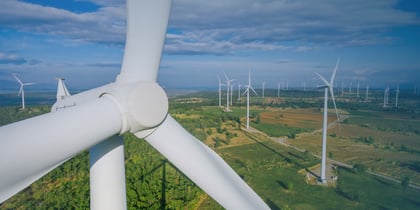
By
Raphael Santos
December 1, 2022
Updated
April 11, 2025
Climate tech, or you could say clean technology, or even cleantech 2.0, is a booming industry attracting billions of dollars in investment and generating new job opportunities.
According to Pitchbook's records, climate tech received $41.1 billion in VC funding in 2022, making it the second-largest year ever, only behind 2021’s record-breaking $48.4 billion. Despite the global economic downturn caused by the COVID-19 pandemic, climate tech proved to be resilient and relevant, as more people became aware of the urgency and importance of addressing the climate crisis.
So, if you've ever wondered about the various aspects of climate tech and how you can contribute to this prosperous field, this article is here to guide you.
By exploring the different emerging sectors, jobs in demand, top skills, upcoming trends, and challenges within climate tech, you'll better understand the vast potential this industry holds and how you can play a part in creating a sustainable future. Therefore, let's dive in and uncover the essentials of climate tech.
What is climate tech and why it matters
Climate tech refers to a wide range of innovative solutions aimed at mitigating and adapting to the impacts of climate change.
Some critical sectors within climate tech include electric vehicles, carbon capture and storage and green hydrogen. These sectors offer solutions to reduce greenhouse gas emissions, increase energy efficiency, and promote a more sustainable use of resources.
They also create value for customers, investors, and society by providing cheaper, cleaner, and more reliable products and services. Climate tech is not only a moral imperative but also a business opportunity, as it can generate positive returns and social impact.
How climate tech sectors are classified and what they do
Carbon tech: capture, store and use CO2
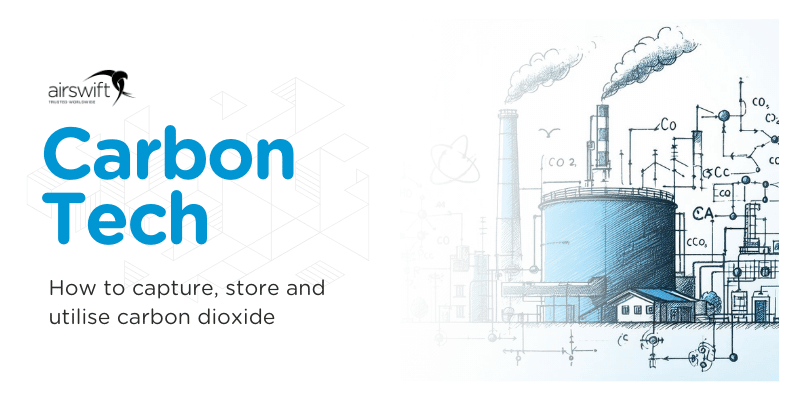
Carbon tech, a revolutionary sector transforming "waste carbon" into valuable commodities in an environmentally friendly manner, is not just a buzzword—it's a burgeoning economic titan.
Picture this: in the U.S. alone, the total available market for carbon tech soars to an astonishing $1.07 trillion annually, while globally, it's an eye-popping $5.91 trillion, according to a report by Carbon180 (a non-profit organisation that advocates for carbon tech).
The report continues to address essential insights: at the heart of this industry is the fuels segment, dominating 85% of the U.S. market and 66% globally. But that's not all. The top three global markets—fuels ($3.82 trillion), building materials ($1.37 trillion), and plastics ($400 billion)—showcase the sector's versatility, spanning from global commodities to high-value consumer products.
The diverse range of products and business models emerging from this sector highlights its potential to impact the economy and the environment significantly.
Energy management software: optimise energy use
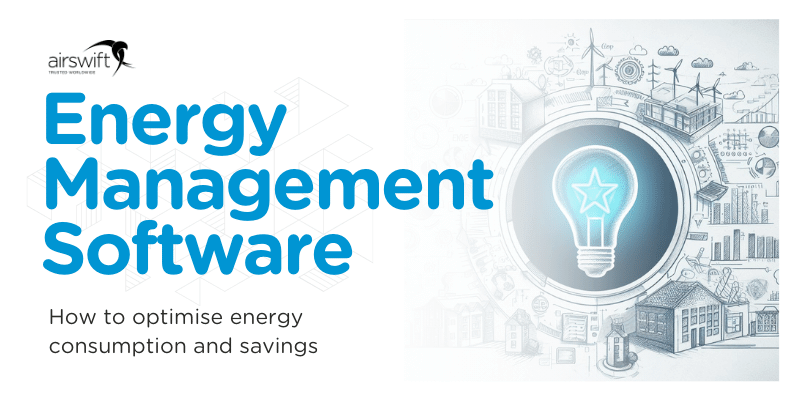
Energy management software (EMS) plays a crucial role in climate tech by providing organisations with the tools to monitor and optimise their energy consumption, reduce greenhouse gas emissions, and achieve sustainability goals.
Besides real-time data and analytics, automation plays a significant role in EMS systems. For example, an EMS can use artificial intelligence and machine learning to learn from historical and real-time data and adjust energy settings and schedules according to user preferences, weather conditions, market prices, and grid signals. An EMS can also use blockchain and smart contracts to facilitate peer-to-peer energy transactions and to ensure transparency and security.
But there's more: an EMS opens up opportunities to be part of virtual power plants. That means you could pool resources like solar panels, batteries, and electric vehicles, collectively acting as a mini power station. By contributing to grid services like frequency regulation, voltage support, and peak shaving, you're not just an energy consumer but an active player in the energy ecosystem.
Concentrated solar power: sun heat to electricity

Concentrated solar power (CSP) is a renewable energy technology that harnesses the power of the sun to generate electricity. Unlike photovoltaic (PV) systems that convert sunlight directly into electricity, CSP uses mirrors or lenses to concentrate the sun's rays onto a receiver, which absorbs the heat and transfers it to a working fluid. This heat is then used to produce steam, which drives a turbine to generate electricity.
With a predicted growth rate of nearly 30% from 2023 to 2035, concentrated solar power is expected to hit a staggering $162.74 billion market size by 2035, up from about $7.05 billion in 2022, according to Research Nester.
Why the surge? Simple: newer systems can concentrate sunlight up to 5,000 times. So, these technological leaps in CSP have made it more efficient and cost-effective, making it competitive with traditional fossil fuels. Plus, it's not just about generating power; it's about doing it responsibly.
Green design: eco-friendly products and services

Green design, also known as cool buildings or eco-design, refers to creating products, systems, and buildings that minimise negative environmental and human health impacts. In climate tech, green design is critical in mitigating climate impacts and reducing greenhouse gas emissions.
Making green design easier: carbon calculators bring another wave of excitement to the green design market. Tools like the One Click LCA calculator allow architects to calculate the full lifecycle impact of their designs, including demolition and disposal.
This comprehensive analysis is crucial for optimising design processes and meeting low-carbon building certification criteria. Now, with a few clicks, we can peek into the carbon footprint of a building right from the get-go.
Direct lithium extraction: faster and cleaner

Direct lithium extraction (DLE) is a method used to extract lithium from both brine and hard rock deposits, offering an alternative to traditional methods.
The method: in brine deposits, lithium is extracted by pumping the brine, a high-concentration saltwater solution, to the surface. Several direct lithium extraction methods are employed, including adsorption, membrane separation, and electrolysis. Learn more about those three:
- Adsorption involves passing the brine through specially designed adsorbents that preferentially capture lithium ions.
- Membrane separation uses selective membranes to separate lithium ions from other elements in the brine.
- Electrolysis involves passing an electrical current through the brine, causing lithium ions to migrate to the cathode for extraction.
DLE has what it takes to be a game-changer tech to make lithium production more sustainable and meet the growing demand for high-purity lithium for batteries and electric vehicles.
Electric vehicles and charging infrastructure: mobility tech
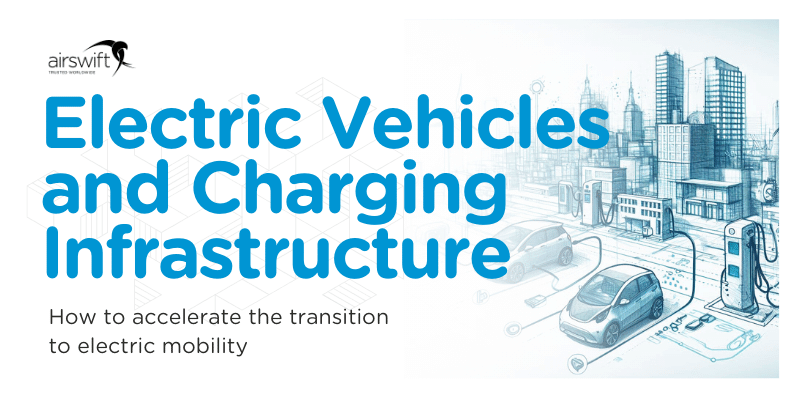
Electric vehicles (EVs) and the associated charging infrastructure are crucial in climate tech. As the world transitions away from fossil fuels and towards cleaner modes of transport, EVs are emerging as a critical solution to reducing greenhouse gas emissions and mitigating the climate crisis.
One of the significant challenges in promoting the widespread adoption of EVs is the need for easily accessible charging stations. Developing a robust charging infrastructure is essential to address "range anxiety" and ensure that EV drivers have convenient and reliable vehicle charge options.
Expanding the charging station network can incentivise individuals and businesses to switch from conventional vehicles to EVs, accelerating the mobility tech sector.
Deep-sea mining: responsible ocean exploration

Deep-sea mining is a concept within the climate tech industry that involves extracting valuable minerals and resources from the ocean floor. This emerging practice has gained attention due to its potential to meet the growing demand for metals and rare earth elements required for clean energy technologies, such as wind turbines, electric vehicles, and solar panels.
The extraction process of deep-sea mining involves using massive machines and equipment to scrape, cut, or vacuum the seabed in search of mineral-rich deposits. These minerals are found in polymetallic nodules, cobalt-rich crusts, and seafloor massive sulfides. Once collected, the minerals are brought to the surface for processing and refinement.
Green hydrogen: renewable hydrogen production and use
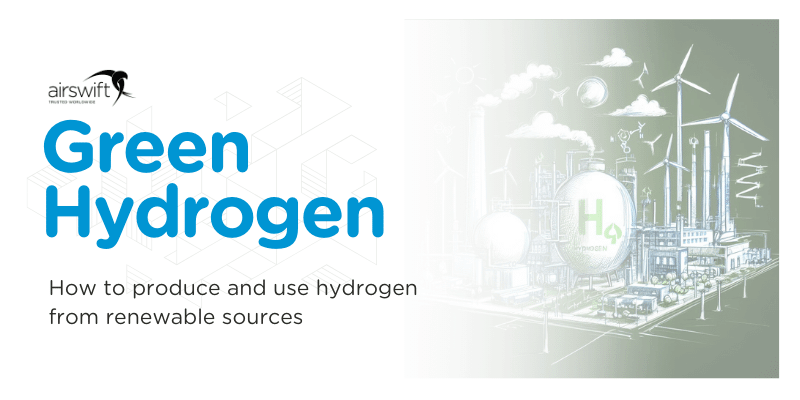
Green hydrogen, also known as renewable hydrogen or clean hydrogen, is produced through the process of electrolysis, using renewable energy sources such as solar or wind power to split water molecules into hydrogen and oxygen. The resulting hydrogen can then be used as a clean alternative to fossil fuels in various sectors such as transportation, industry, and power generation.
One of the curiosities about green hydrogen is that it is the most abundant element in the universe, but rare in its pure form on Earth. Hydrogen is usually found in combination with other elements, such as oxygen in water or carbon in fossil fuels.
The first unicorn: Electric Hydrogen, recently raised $380 million, putting the startup over the $1 billion valuation. The company's x-factor lies in its technology. They developed larger and more efficient electrolysers, resulting in lower costs and improved performance.
Government subsidies significantly contribute to the cost-effectiveness of many of these technologies. Green hydrogen and other climate technology sectors align with the direction we desire for our world.
Sustainability is no longer just a personal mission; it's a way to leave a lasting legacy in our daily work lives. And some companies are rocking it and getting recognised for leading the charge in building this fantastic legacy.
The climate tech companies you should know about
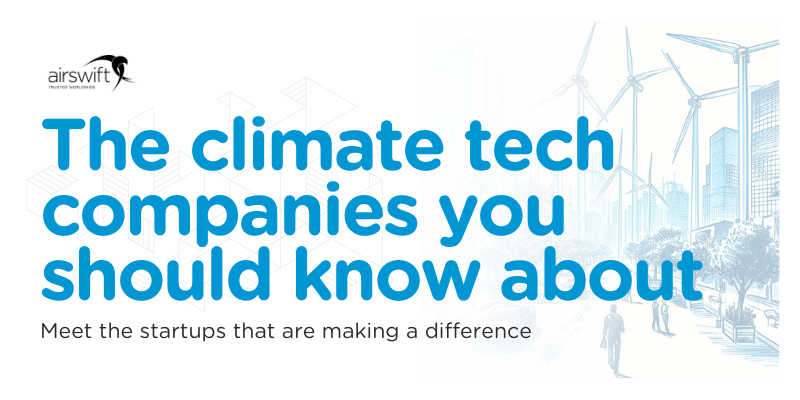
Climate tech is currently experiencing a renaissance after a turbulent past decade. The industry has undergone significant changes, with more mature technologies, increased consumer consciousness, and better government support. As a result, numerous unicorns are emerging in the industry, creating new job opportunities and career paths. See below in our chart the leading climate tech unicorns:
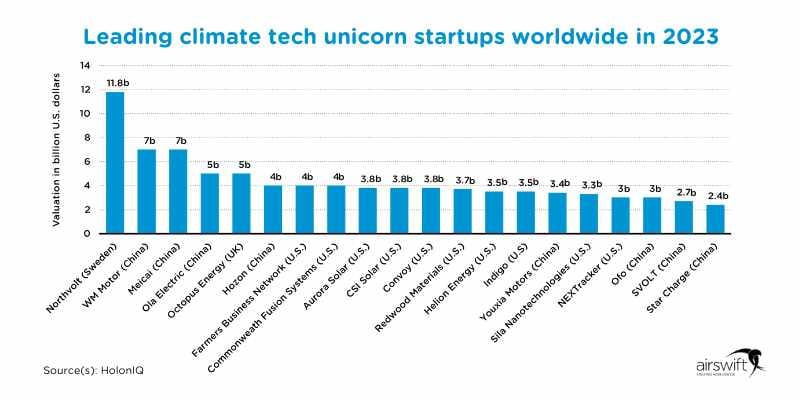
Those renewable energy startups shown in the chart, like Northvolt ($11.8 billion valuation), Octopus Energy ($5 billion valuation), Aurora Solar ($3.8 billion valuation) and Indigo ($3.5 billion valuation), are playing a critical role in the global climate tech market.
With a staggering 2,800 climate tech companies globally, these startups have emerged as critical players in driving innovation and the necessary changes to combat the climate crisis.
In recent years, there has been a significant surge in investor interest in climate tech, with 1,642 VC-backed climate tech companies established since 2020. These startups have attracted substantial investments, highlighting the growing recognition of their potential to tackle greenhouse gas emissions and create a sustainable future.
These visionary companies hold the key not only for the future of technology but also for the most coveted careers. So, we plunged headfirst into the enchanting world of these unicorn climate techstars, uncovering the most sought-after positions they are eagerly seeking.
How to break into the climate tech industry
![]()
The most in-demand climate tech jobs
I've analysed 382 job openings in the tech and STEM fields offered by some of those leading unicorns on LinkedIn. These are the most in-demand climate tech jobs I found during the research:
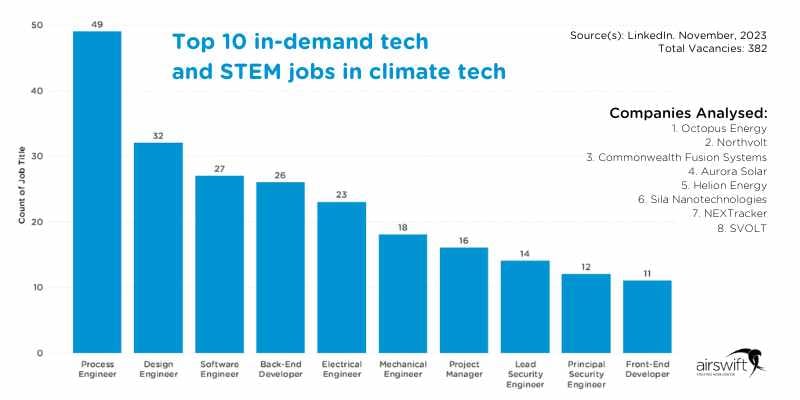
At the forefront are Process Engineer, Design Engineer and Software Engineer, with 49, 32 and 27 listings respectively. Close behind are Back-End Developer (26), Electrical Engineer (23) and Mechanical Engineer (18).
It's interesting to see the consistent demand for Project Managers (16) in today's industry. Finally, Lead Security Engineer (14), Principal Security Engineer (12) and Front-End Developer (11) complete the top ten.
Climate change engineering jobs and salaries: how to fit into this position
We can say that the previous chart represents the professions of the future. The need to address the climate crisis and the nature of these roles are both reasons for this.
For instance, working in process engineering involves anticipating future solutions to solve current process issues. And considering careers like Design Engineer, we step into the same demand, which here requires a combination of engineering and creative design skills.
This shows the exciting nature of the climate tech industry, where innovative solutions and future predictions are in high demand.
To contribute to the advancement of this field, regardless of a specific job title, it is necessary to adopt the mindset of a climate change engineer. This entails applying engineering principles and data science to analyse and address the causes and effects of climate change. Below are a few examples of climate change engineering positions to provide a clearer understanding of how you can fit into one of them:
- Environmental engineer: use their skills and knowledge to design and improve systems that keep the environment clean and healthy. They work on projects like water purification, waste management, air quality control, and environmental restoration. According to Payscale, their average salary in the United States is $70,753 per year.
- Energy / Renewable energy engineer: these engineers research, develop, and implement technologies that generate, store, and distribute green energy. They work on projects like solar panels, wind turbines, biofuels, batteries, and smart power grids. According to Payscale, their average salary in the United States is $75,359 per year.
- Design engineer: they create and modify the physical aspects of products, systems, and structures that meet the needs and wants of clients and users. You see them work on projects like CAD modelling, prototyping, testing, and optimisation. According to Payscale, their average salary in the United States is $72,990 per year.
- Process engineer: we can also call these professionals "the efficiency experts of engineering", since they analyse, design, and optimise the operations and performance of industrial processes and systems. They work on projects like chemical engineering, manufacturing engineering, petroleum engineering, and biotechnology engineering. According to Payscale, their average salary in the United States is $79,164 per year.
- Automation engineer: they develop and maintain the software and hardware that control and monitor automated systems and processes. Automation engineers work on projects like robotics, machine learning, artificial intelligence, and internet of things. According to Payscale, their average salary in the United States is $83,198 per year.
- Computer vision engineer: as the name suggests, these engineers develop and implement computer vision algorithms and models, integrate them into software systems, and optimise them for performance and scalability. They work on projects like image processing, pattern recognition, and machine learning. According to Payscale, their average salary in the United States is $118,267 per year.
- Nuclear engineer: they use nuclear physics and engineering to design, analyse, and optimise nuclear systems and materials. They work on projects such as nuclear fusion reactors, radiation shield vaults, and nuclear waste management. These experts are hired to advise on the effects of radiation on materials, perform literature reviews and data analysis, and operate in a dynamic environment. According to Payscale, their average salary in the United States is $93,417 per year.
- Embedded firmware engineer: if you are skilled at programming and electronics, you might like being an embedded firmware engineer. Embedded firmware engineers develop and program the software that runs on embedded systems and devices. They work on projects like microcontrollers, sensors, actuators, and communication modules. According to Payscale, their average salary in the United States is $90,455 per year.
- Geotechnical engineer: these engineers study and evaluate the behaviourr and properties of soil and rock, and their interactions with structures and foundations. They work on projects like tunnels, dams, bridges, buildings, and mines. According to Payscale, their average salary in the United States is $72,174 per year.
- Lead security engineer: the professional who oversees and manages the security aspects of software systems and networks. They work on projects like security architecture, threat modelling, vulnerability assessment, penetration testing, and incident response. According to Payscale, their average salary in the United States is $100,098 per year.
How to land an entry-level job in climate tech
Recruiters seeking fresh talent know that it takes more than just math and logical thinking to stand out in the field of climate tech; it takes more than just engineering skills.
Candidates for entry-level tech jobs in climate tech companies must possess a combination of basic skills in those high-demand tech fields: data, engineering, marketing and design.
Below are examples of tasks that may be encountered in a climate tech company. Take the time to read and understand these practical cases, ensuring that you have a basic proficiency in each skill set so that you can contribute effectively to the team.
Remember that these cases will be worked on together with your squad, so don't be intimidated by these challenges, and start to study so you can have initial fluency.

- Data skill set:
- A practical case for data skills is to create a dashboard that shows the carbon footprint of different countries and sectors, and how they are changing over time. You can use Python or R to scrape and clean data from websites like Global Carbon Atlas or Our World in Data, and use SQL to store and query the data in a database.
- You can use TensorFlow or PyTorch to build a machine learning model that predicts future carbon emissions based on historical data and various factors, such as population, GDP, energy consumption, and policies. You can use Tableau or PowerBI to create interactive and dynamic visualisations that display the data and the model results in a user-friendly and informative way.
- A practical case for data skills is to create a dashboard that shows the carbon footprint of different countries and sectors, and how they are changing over time. You can use Python or R to scrape and clean data from websites like Global Carbon Atlas or Our World in Data, and use SQL to store and query the data in a database.
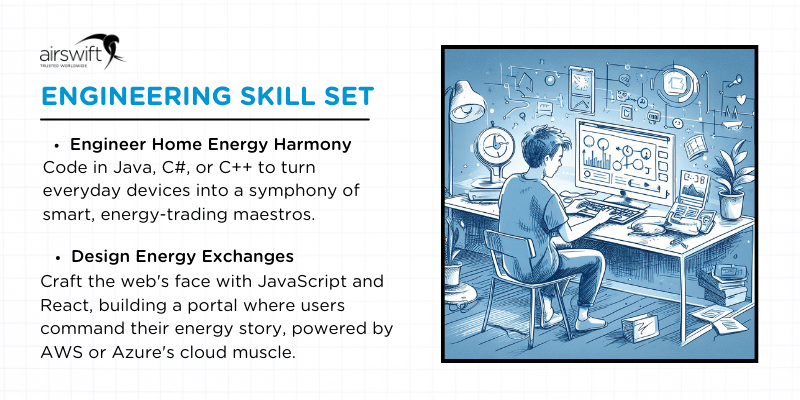
- Engineering skill set:
- A practical case for engineering skills is to create a web app that allows users to monitor and control their home energy consumption and generation, and to trade excess energy with other users or the grid. You can use Java, C#, or C++ to program the hardware devices, such as smart meters, solar panels, batteries, and appliances, that communicate with the web app via internet of things protocols.
- You can use JavaScript, HTML, CSS, React, or Angular to create the front-end of the web app that displays the real-time and historical data of the energy usage and production, and allows users to adjust their settings and preferences. You can use AWS or Azure to host the back-end of the web app that handles the data processing, storage, and security, and uses blockchain to facilitate the peer-to-peer energy transactions.
- A practical case for engineering skills is to create a web app that allows users to monitor and control their home energy consumption and generation, and to trade excess energy with other users or the grid. You can use Java, C#, or C++ to program the hardware devices, such as smart meters, solar panels, batteries, and appliances, that communicate with the web app via internet of things protocols.

- Marketing skill set:
- A practical case for marketing skills is to create a marketing campaign for a climate tech startup that offers a platform for carbon offsetting and climate action. You can use Google Analytics to analyse the web traffic and user behavior of the startup’s website, and identify the target audience, segments, and personas.
- Write the company's blog so you can use it to address inquiries pertaining to both significant and minor issues encountered by the audience. It can also serve as a means to educate this audience about the platform's features, benefits, and impact, and motivate them to sign up and engage.
- You can use Wordpress or HubSpot to create and update the website’s content, such as blog posts, testimonials, case studies, and FAQs, that showcase the platform’s value proposition and success stories. For managing the social media accounts of the startup, rely on Hootsuite for posting relevant content that attracts and interacts with the followers. Also, you can use Canva to create and design the visual elements of the marketing campaign, such as logos, banners, flyers, and infographics, that convey the brand identity and message of the startup.
- A practical case for marketing skills is to create a marketing campaign for a climate tech startup that offers a platform for carbon offsetting and climate action. You can use Google Analytics to analyse the web traffic and user behavior of the startup’s website, and identify the target audience, segments, and personas.
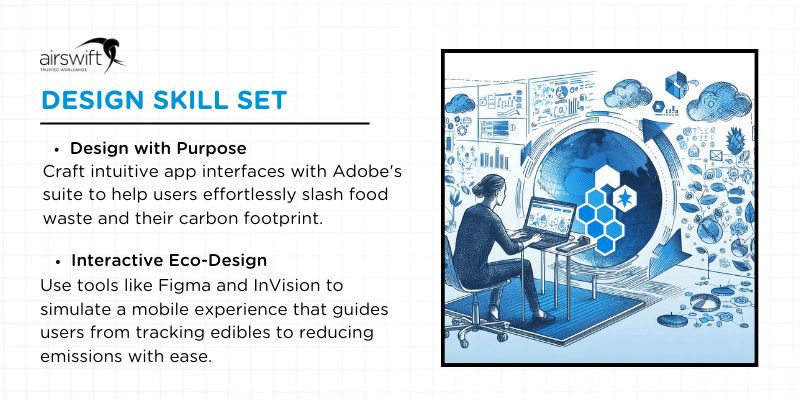
- Design skill set:
- A practical case for design skills is to create a user interface and user experience for a mobile app that helps users reduce their food waste and carbon footprint. You can use Adobe Photoshop, Illustrator, or InDesign to create the wireframes, mockups, and prototypes of the app’s screens, icons, buttons, and menus, that follow the best practices of mobile app design and accessibility.
- You can use Sketch, Figma, or InVision to create interactive and high-fidelity prototypes of the app’s features and functionalities, such as scanning food items, tracking expiration dates, suggesting recipes, calculating carbon emissions, and providing tips and feedback.
- In addition, put into practice some design thinking and human-centred design methods, such as interviews, surveys, personas, user journeys, and usability testing, to understand the users' problems, needs, and goals, and to evaluate and improve the app’s design and user experience.
- A practical case for design skills is to create a user interface and user experience for a mobile app that helps users reduce their food waste and carbon footprint. You can use Adobe Photoshop, Illustrator, or InDesign to create the wireframes, mockups, and prototypes of the app’s screens, icons, buttons, and menus, that follow the best practices of mobile app design and accessibility.
Keep in mind that crafting an impeccable resume is crucial for showcasing your abilities in the most compelling way to potential employers. Seize now the opportunity to elevate your resume by downloading our exclusive collection of top-tier AI prompts for free!
How to advance your career in climate tech: senior roles and opportunities
To advance your career in climate tech, you will need to demonstrate your knowledge and passion for solving climate challenges and creating a positive impact. Here are some steps you can take to achieve your goals:
![]()
- Learn new skills to advance your career: You can enrol in online courses, workshops, or programs that teach you the latest trends, technologies, and best practices in climate tech. For example, you can check out:
- The Future of Sustainable Business course at Oxford University.
- The Business Sustainability Management course at the University of Cambridge.

- Help promote transparent national reporting of climate data: You can apply to become a technical expert for the UN Climate Change and assist developing countries in preparing their national communications and biennial update reports on their greenhouse gas inventories, mitigation actions, and support needs.
This will help you gain valuable experience, network with other experts, and learn from other countries’ efforts to fight climate change.

- Apply your expertise to benefit other countries: You can also join the Climate Technology Centre and Network, a UNFCCC body that provides technical assistance and capacity building to developing countries to accelerate the transfer and deployment of climate technologies.
You can register as a network member or a consultant and offer your services to support climate tech projects in various sectors, such as energy, agriculture, transport, and waste management.

- Increase your network and meet new colleagues from around the world: You can join online communities and events that focus on climate tech topics and issues, such as the Climate Change AI, a monthly round-up of events and opportunities for those who want to use artificial intelligence to tackle climate change.
You can also attend local or virtual meetups, hackathons, competitions, or challenges that involve climate tech solutions. These will help you connect with like-minded people, learn from their experiences, and discover new opportunities.

- Pursue new opportunities: You can browse the job boards and identify opportunities that match your skills, interests, and values. You can also create a portfolio of projects, articles, or other relevant work that showcases your passion and knowledge for climate tech.
Use online platforms like Medium, GitHub, or YouTube to share your work and get feedback from others. Plus, reach out to climate tech professionals and ask for referrals, advice, or mentorship, especially if you're looking to move from Oil & Gas to clean energy.
How to lead the climate tech revolution: C-Level roles and responsibilities
There are many MBA and executive programs that can help you pursue a C-level career in climate tech, depending on your goals, interests, and background. Here are some of the top programs:
- The Executive MBA program at Warwick Business School is a 24-month blended program ranked 3rd in the UK and 20th in the world by the Financial Times 2023 Executive MBA ranking. There, you'll be able to choose from various electives and specialisations, such as Entrepreneurship, Social and Environmental Sustainability.
- The MBA program at Griffith Business School may be what you're looking to level up your climate tech career. This MBA is ranked as the best sustainability MBA in the world by Corporate Knights. It focuses on responsible leadership, sustainable business practices, and still has an Asia-Pacific Study Tour so you can gain new market perspectives.
- The Climate Change and Business Program at Yale School of Management is a six-week program that equips leaders with carbon management and disclosure skills. It aims to give you the tools on how to create a strategy for managing climate change risks and reducing a business's carbon footprint.
- The Executive MBA program at HEC Paris features a flexible and customisable curriculum, with a choice of 8 majors and 50 electives, as well as a strategic professional project that can be aligned with your career aspirations. You can also enrol in the MBA's specialisation, "Shape the Future of Energy". This course, which takes place over one week in Doha and one week in Berlin, will help to expand your industry network and learn visionary strategies for the current energy revolution. HEC's program is ranked 3rd in the world by the Financial Times 2023 Executive MBA ranking.
- The Beahrs Environmental Leadership Program (ELP) at UC Berkeley (Rausser School) is a three-week intensive training program for environmental professionals from around the world. The program is offered by the College of Natural Resources and aims to enhance the skills and knowledge of environmental leaders to address complex and interrelated issues such as climate change, biodiversity conservation, food security, and poverty alleviation.
- The MBA in Energy and Clean Technology at UC Berkeley (Haas School) is where students can leverage the BERC network, the Berkeley Haas Alumni Network, and the Career Management Group's energy industry specialist to pursue careers in companies like Bloom Energy, Chevron, PG&E, and Tesla. The program offers specialised courses like 'Energy and Environmental Markets', 'Energy and Infrastructure Project Finance', and a 'Renewable Energy Speaker Series'.
- Executive MBA in Green and Digital Transition at Graz University of Technology stands out for its climate tech market focus. This program prepares managers for strategic and operational roles, focusing on scientifically informed, action-oriented training. The program lasts for 18 months and offers modular options for selecting individual courses. Modules in "Digital Transformation" cover topics like the Digital & Green Economy, Innovation Management, and Applied Digital Transformation. The "Green Transition / Zero Carbon Management" modules delve into Decarbonisation, Energy & Green Production, and Sustainable Buildings.
The essential skills for climate tech professionals
The top tech skills for climate tech jobs
According to a comprehensive study published in Climate Risk Management (2022) issue, various digital technologies are paving the way for innovative approaches to climate resilience. These technologies facilitate real-time data analysis, predictive modelling, and strategic decision-making, which are essential components of effective climate change mitigation and adaptation strategies.
This evolution requires a workforce skilled in a specific set of technical competencies, capable of leveraging these technologies to their fullest potential in the realm of climate tech. So, whether you are a recruiter seeking top talent or an aspiring climate tech enthusiast, the following information outlines the necessary skills for driving this industry.
- Knowledge of 5G technology for real-time data transmission and processing.
- Expertise in artificial intelligence (AI) for modelling, simulation, and decision-making processes.
- Familiarity with augmented reality (AR) for enhanced visualisation and interaction with climate data and models.
- Proficiency in big data handling, analysis, and application in climate-related projects.
- Skills in building information modeling (BIM) for sustainable construction and infrastructure management.
- Cybersecurity measures to protect climate data and infrastructure.
- Competency in data analytics for interpreting complex climate datasets.
- Techniques in data mining for uncovering patterns in large climate datasets.
- Development and management of digital twins for climate resilience in infrastructure.
- Use of global navigation satellite system (GNSS) for precise location tracking and monitoring.
- Implementation of Internet of Things (IoT) devices for data collection and monitoring in various environments.
- Application of machine learning algorithms to predict climate patterns and effects.
- Techniques in photogrammetry for capturing accurate environmental data.
- Proficiency in R programming for statistical analysis and modelling in climate research.
- Skills in remote sensing for monitoring and assessing environmental changes.
- Interpretation of satellite imagery for climate monitoring and land use/land cover analysis.
- Operation and deployment of unmanned aerial vehicles (UAV) for data collection in remote or affected areas.
- Utilisation of virtual reality (VR) for simulation and immersive experience in climate education and research.
The green skills that will make you stand out in climate tech
LinkedIn's Global Green Skills Report 2023 underscores the importance of greener technological expertise in driving the transition towards sustainable practices across industries.
Among the critical tech-related green skills identified, proficiency in renewable energy systems is paramount, especially in harnessing solar technology. Energy efficiency techniques emerge as another key area, emphasising the need for skills in implementing cutting-edge energy-saving solutions. The report also highlights the growing field of green information technology, which aims to minimise the ecological footprint of digital infrastructure.
These green tech-centric skills are crucial in achieving the ambitious goals of environmental conservation and sustainability:
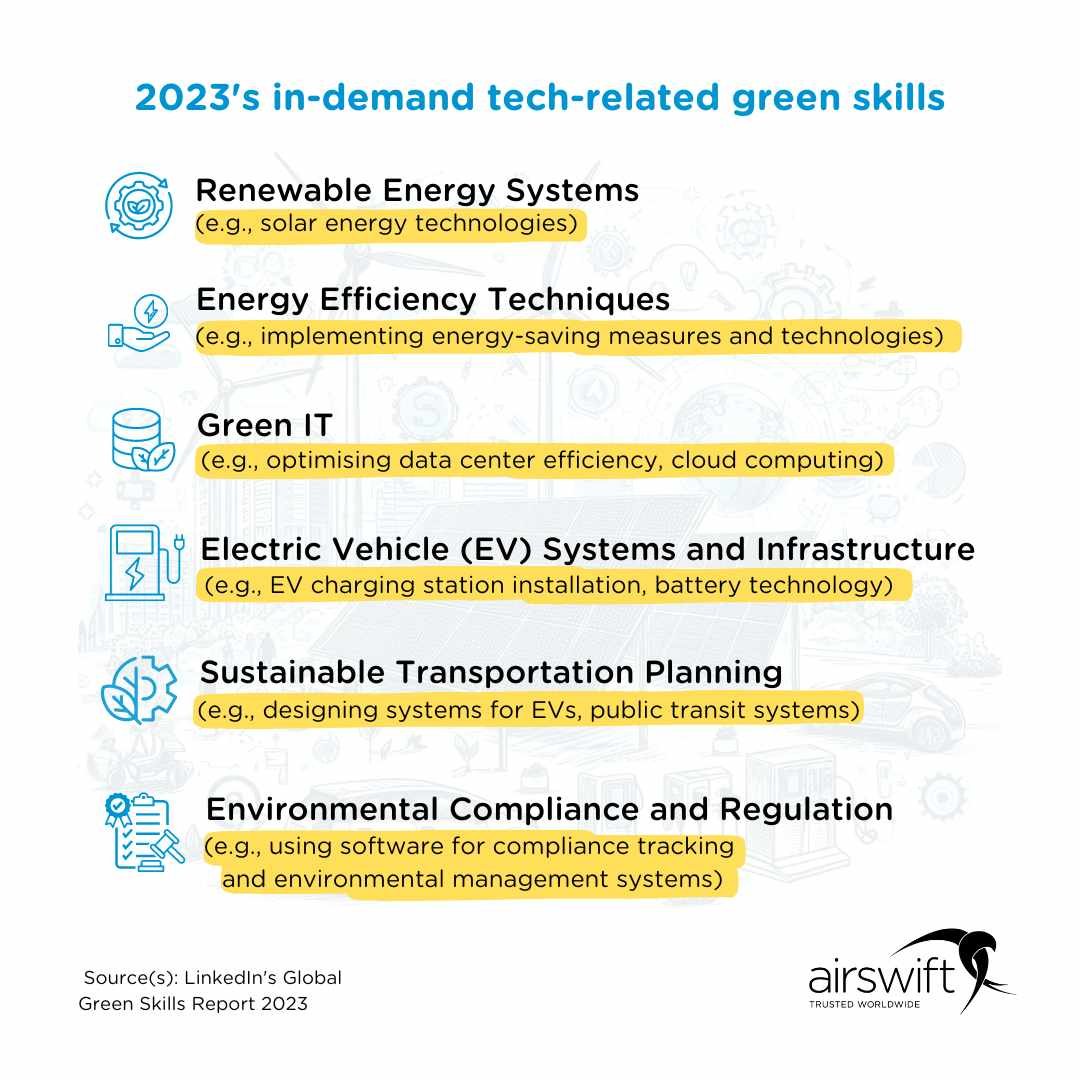
A climate tech worker's point of view: the skills and mindset
Harrison Mendonça is a front-end developer at Persefoni, a leading company in the field of climate management and accounting. Their software-as-a-service platform enables enterprises and financial institutions to measure, report, and reduce their carbon footprint.
Working at one of the most innovative companies, as recognised by Fast Company, undoubtedly requires a strong skill set to perform at a high level. And this is what our interviewer tries to clarify for us:
“I currently work with front-end development, so this knowledge is essential. As our app uses Next.js (React), this is the primary framework we need to master. But extra knowledge is highly valued, such as AWS, Docker, GraphQL, Auth0.”
The key to success is fitting in with the company's composition and being eager to learn. Harrison also points out that some skills are essential regardless of how often you use them, as they are standard tools that demand a basic proficiency level to keep up with the pace. One must-know tool is Figma, the interface design champ. And if you can handle task management like a pro (JIRA is another common ground here), you'll show everyone just how mature you are in your tech role.
And for those thinking about making this transition, to pursue a purpose in fighting the climate crisis through technology. Harrison offers a word of wisdom:
“It is very important that you are dedicated to what you do. This is easily noticed and valued in everyday life. And to be dedicated, you need to be interested and be a believer. If you are changing areas, they will hardly require you to have a background in this, especially because the whole subject is recent and growing. But they will require you to be interested in learning.”
So you've got the message! Abbreviations and technical names are commonly used in this industry, including some related to complex legal subjects. However, it is highly encouraged to ask questions and demonstrate interest and a willingness to learn. You are entering a new industry to develop new solutions, so there is no need to be intimidated. Instead, be eager and proud to be at the forefront of the fight against climate change.
Climate tech trends: emerging and evolving opportunities
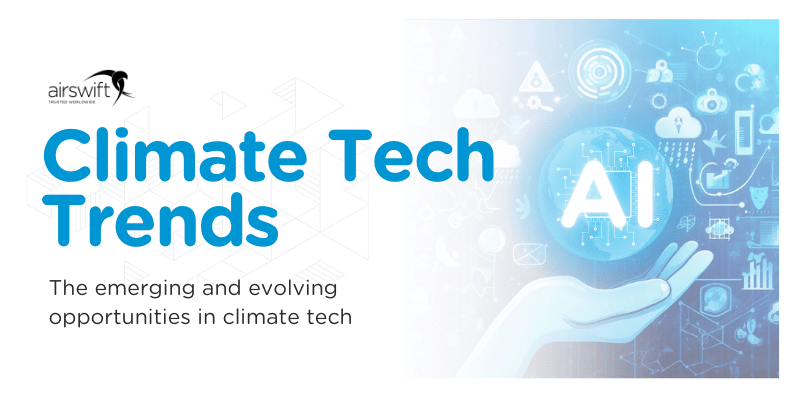
What is science pointing out?
As we delve into the dynamic realm of climate tech trends, a recent research of the international peer-reviewed journal, Sustainability, offers insightful revelations:
- Interdisciplinary growth: The nexus between climate change and the circular economy (CE) is not only burgeoning but also distinctly interdisciplinary, showcasing Europe's leadership in scientific inquiry and innovation.
- Waste management and mitigation: Waste management emerges as the pivotal CE strategy linked to climate change, while mitigation efforts are most significantly influenced by CE practices, underscoring the urgency to develop greener waste processing and mitigation technologies.
- Future directions: Foreseeing the trajectory of climate tech, researchers advocate for a concentrated focus on bioeconomy, the intersection of climate and energy, and the enhancement of sustainability through natural resources management, with carbon recovery and green materials as areas ripe for breakthroughs.
- Addressing gaps: An imperative shift is noted towards integrating social dimensions, bolstering climate change adaptation measures, and fortifying the relationship with Sustainable Development Goal (SDG) 13, all of which present untapped potential for innovation in climate technology.
What is the market pointing out?
To gain a better understanding of the market, take a closer look at the list below, which showcases the top climate tech deals of 2023.
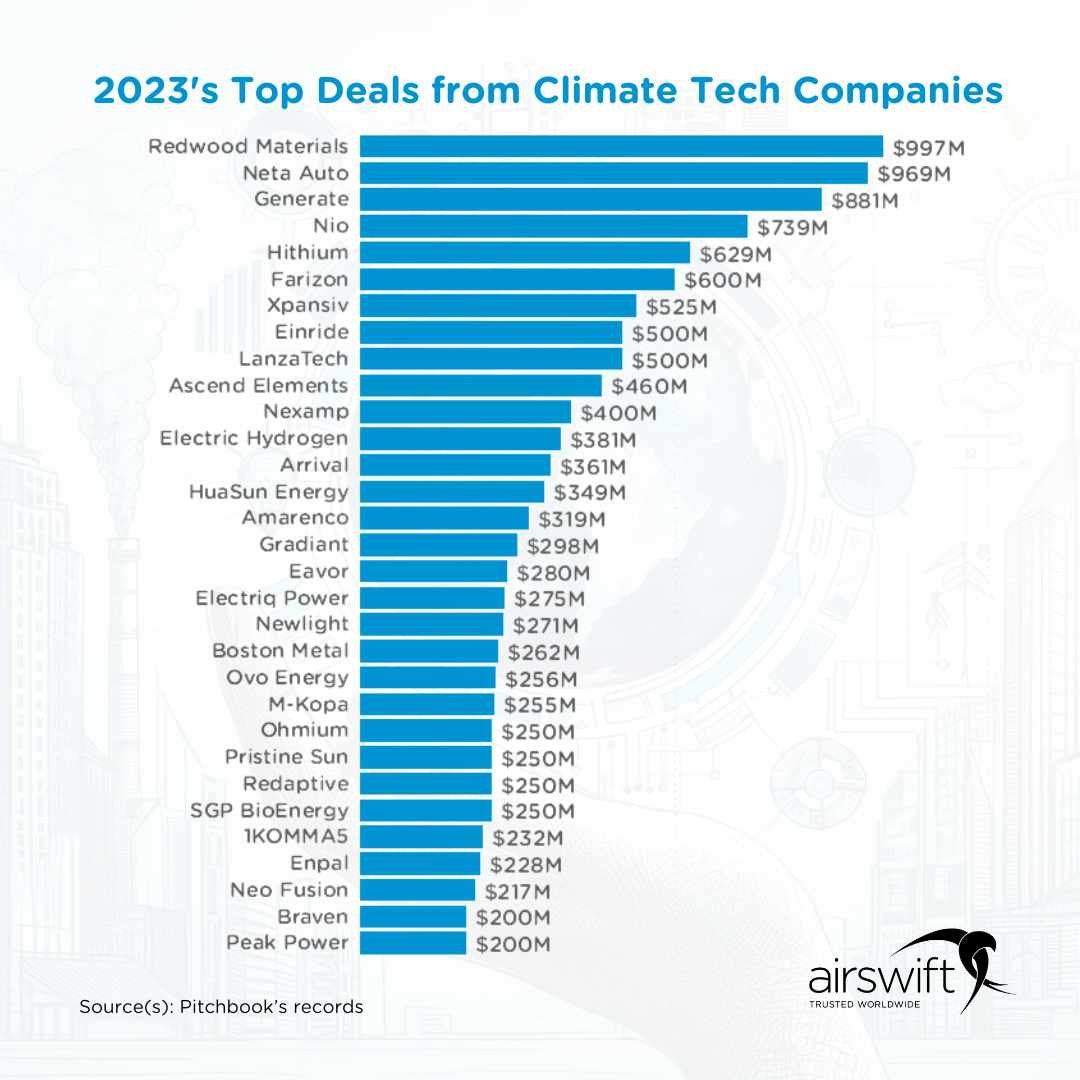
The hottest climate tech startups hiring
In 2023, the top climate tech deals not only represent a significant stride in environmental innovation but also signal the rise of the hottest climate tech startups in the hiring landscape.
These trailblazing companies, like Neta Auto ($969 million), Farizon ($600 million) and LanzaTech ($500 million), now flush with fresh funding, are uniquely positioned to attract top talent, fueling their growth and bolstering their capabilities.
As they secure substantial investments, these startups are poised to reinvest in themselves, expanding their teams with skilled professionals who share their passion for tackling climate challenges.
This influx of capital thus serves a dual purpose: accelerating climate solutions and creating exciting career opportunities in a sector that's increasingly crucial for our planet's future.
Naturally, those trends lead to a pivotal question: How do advancements in AI technology intertwine with today's climate tech market?
How do AI and climate change figure in those trends?
Let's dive right in and answer this question by looking at the top deals closed this year in the AI climate tech field.
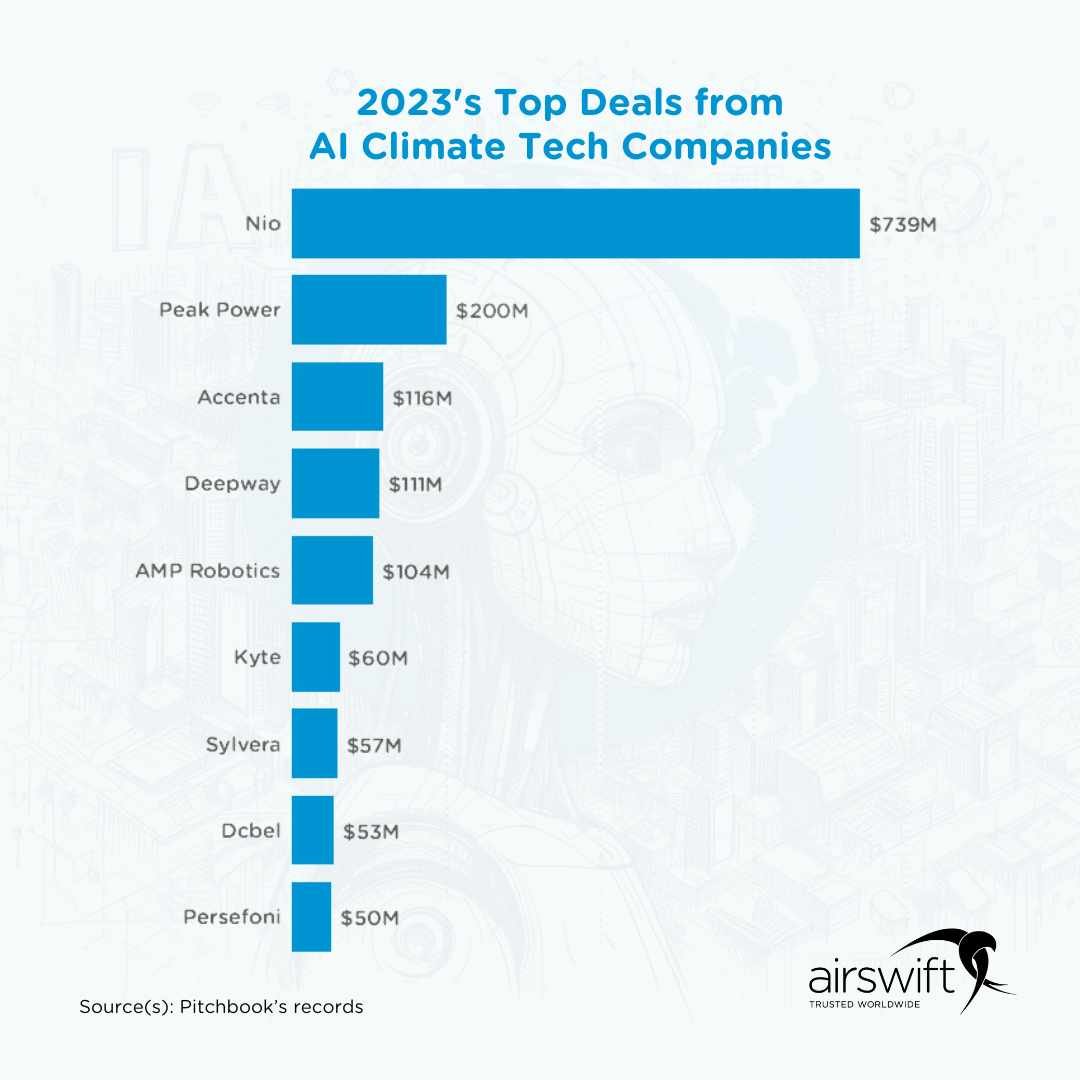
The intersection of AI and climate tech is creating unprecedented opportunities for innovation, enabling us to tackle environmental issues more effectively and sustainably than ever before. Here's how AI and climate tech trends are shaping the future:
- AI in climate mitigation and adaptation: AI's data-crunching prowess is being harnessed to better forecast extreme weather events, allowing for more efficient energy use, enhanced crop growth with less water, and smarter electric vehicle routing to reduce emissions significantly.
- Nio is a notable example of a company outshining in this field. The leading electric vehicle maker recently secured $739 million in financing. This investment underscores the growing importance of AI in developing efficient electric vehicles, promising up to a 50% reduction in emissions by 2050 due to efficient routing and increased ride-sharing opportunities.
- AI in energy and efficiency: AI excels in managing renewable energy sources, enhancing battery storage, and improving carbon capture. It's also pivotal in creating stronger, lighter materials for wind turbines or aircraft, contributing to lower energy consumption.
- Peak Power, an AI-powered energy optimisation platform, recently raised $35 million in Series A funding, illustrating the market's confidence in AI solutions for renewable energy management. Similarly, Accenta, a renewable energy storage platform, secured $116 million to further its innovations in this space.
- AI in carbon footprint management: these innovative platforms represent a paradigm shift in environmental accountability for businesses. By integrating artificial intelligence, it offers a sophisticated solution for measuring and analysing carbon emissions in real-time. The platform streamlines sustainability reporting, ensuring compliance and facilitating transparent communication between companies, investors, and stakeholders.
- Persefoni, the developer of a carbon footprint management platform already mentioned in this content, exemplifies this trend by raising $50 million in Series C-1-A funding, showcasing the growing demand for sophisticated tools in carbon accounting and sustainability reporting. Additionally, AMP Robotics, an advanced recycling infrastructure developer, raised $104 million in Series C funding, further reflecting the surge in AI-driven solutions for waste management and carbon footprint reduction.
However, AI's environmental cost cannot be overlooked:
- Energy consumption of AI: The burgeoning carbon footprint of AI, particularly from data centres, which consume 2.5 to 3.7% of global greenhouse emissions, poses a challenge. These centres run non-stop, mostly on fossil fuels, and the demand is expected to rise with the increasing complexity of AI models, according to a recent publication by Columbia Climate School.
- Cooling and operation: AI systems and data centres require vast amounts of electricity not just for operation but also for cooling, as about 40% of their energy use goes towards preventing overheating.
The balance between AI's potential in combating climate change and its own environmental impact is delicate. On one hand, AI offers unprecedented tools for efficiency and sustainability. On the other, the industry must navigate the energy demands of these technologies.
The key lies in continual innovation within AI to make the technology not just a tool for combating climate change, but also an exemplar of sustainable practices. Plus, the environmental concern is not the only challenge for many companies. Most startups and major organisations need help with the following roadblocks when scaling their business.
Climate tech challenges: barriers and risks
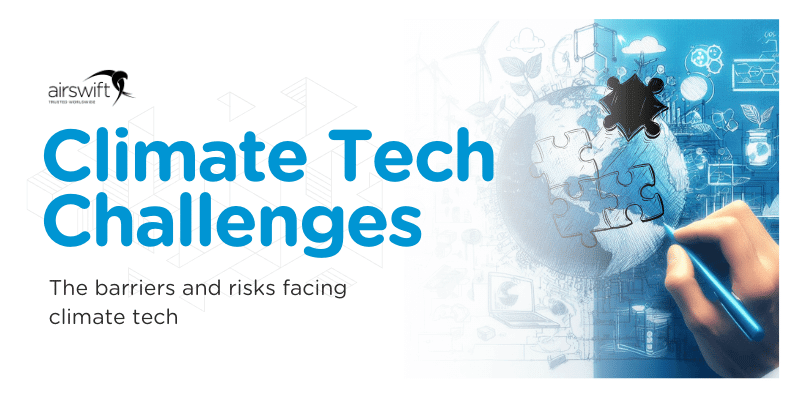
Climate tech companies, while striving to innovate and contribute to environmental sustainability, face a multitude of challenges that can hamper their growth and impact. These challenges often overlap with those faced by the broader tech industry but are also unique due to the nature of their goals and the technologies they develop. Here are some of the key challenges identified:
- Scaling operations and talent acquisition: As the climate tech sector grows, companies need help scaling their engineering and technology operations, with 68.5% of climate tech startups citing this as a challenge. Furthermore, recruiting the right talent is crucial, with 61.7% of companies recognizing the need to attract skilled professionals who are passionate about sustainability.
- Supply chain disruptions: The COVID-19 pandemic has significantly impacted the supply chains that are crucial for the development and innovation of climate tech products. The reliance on specific materials and processes means that disruptions can delay projects and increase costs, making it difficult for smaller businesses to compete with larger corporations. There are also broader concerns regarding the sourcing and distribution of materials due to various restrictions imposed by countries.
- Government policy and funding: Government policies greatly influence the climate tech industry, particularly because many of these technologies rely on government funding to become economically viable. The Inflation Reduction Act, for example, allocates significant funds to combat climate change, highlighting the need for companies to understand and navigate these policies to scale effectively. Companies must also consider the cost competitiveness of their green technologies in the face of policies and subsidies that may favour traditional energy sources.
- Technology readiness for scaling: For deep-tech climate tech companies, it is critical to assess if the technology has reached scientific milestones that indicate readiness for commercialization. Unique business models, like innovative ways to market heat pumps or solar solutions, require novel go-to-market strategies. Overall, companies need to evaluate the market readiness of their technology, the impact of government policy, and their business strategy before scaling up.
- Cultural and mission-driven recruitment: Building a company culture around a mission to address climate change can provide a recruitment advantage. Companies need to attract mission-driven individuals who are motivated by the cause rather than just salary, which can lead to a unique company culture and potentially more sustainable growth.
These and other top challenges underline the need for climate tech companies to be adaptive, policy-savvy, and innovative in their approach to scaling, all while staying true to their mission of contributing to the fight against climate change.
The way forward for you to succeed in climate tech

By now, you're aware that we're talking about a very exciting emerging industry in which your path to success depends greatly on who you are in this grand momentum. If you're on the hunt for a job, think of this climate tech page as your treasure map. It's chock-full of nuggets—resources, tips, and industry insights—that could lead you to your golden opportunity. Dive into the knowledge pool, get savvy with the latest trends, and tailor your skills to what the market craves.
But what if you're the captain of your own climate tech ship? — a company, a founder —, the waters get a bit trickier to navigate. It's not just about riding the waves; it's about understanding the ocean's depths. Educate yourself about the looming challenges, the trends that are reshaping the horizon, and the market dynamics. Learn about the tech that's pushing boundaries. And here's a twist: Sometimes, the smartest move is to join forces with someone who knows these waters well.
That’s where Airswift sails in. Here, we partner with top-notch companies to find and nurture the most exceptional talent. With over 60 offices spanning the globe, a dedicated team of 1000+ employees, and a network of 9,000+ contractors, we have the expertise and global reach to solve any problem you may have.
So, let's raise the anchor and set course for success, together. It's time to elevate your company to new heights! Contact us now and discover how our services can transform your business.



